The Belt and Road Initiative: Multilingual Opportunities and Linguistic Challenges for Guangxi, China
Chen Bing*
Guangxi University
Abstract: The Belt and Road Initiative (BRI) is to construct a large unified market, to make full use of both international and domestic markets, and to enhance the mutual understanding and trust of member nations of Association of Southeast Asian Nations (ASEAN) through cultural exchange, people-topeople ties and integration.Geographically adjacent to ASEAN countries and is close to India and Bangladesh in South Asia, Thailand and Cambodia in Southeast Asia, Guangxi Zhuang autonomous region of China is a key littoral or southern gateway for China’s BRI.Foreign language planning is an essential element for the social development of a country economically and culturally.By reviewing the implementation of the foreign language policy in Guangxi, I analyzed the multilingual opportunities and linguistic challenges in the region, which shares the cross-border languages with its neighboring countries in the multi-ethnic and multi-lingual community, to reveal the sociological meaning of the foreign language policy beyond its linguistic meaning, and propose an English-plus multilingual policy approach toward the ASEAN countries to meet the current needs of communications associated with the BRI.
Keywords: the Belt and Road Initiative (BRI), multilingual opportunities, linguistic challenges, Guangxi
Introduction
The Belt and Road Initiative (BRI) adopted by the Chinese government in 2013 calls for the integration of the region into a cohesive economic area through building infrastructure,increasing cultural exchanges, and broadening trade.The BRI aims to construct a large unified market, to make full use of both international and domestic markets, and to enhance mutual understanding and trust between member nations through cultural exchange, people-to-people ties,and integration.Being one of the largest infrastructure and investment projects in history, the BRI covers more than 68 countries, including 65 percent of the world’s population and 40 percent of the global GDP (Xinhua News, 2018).Chinese President Xi Jinping stated the necessity of building modern maritime infrastructure and developing transport routes between China and the ASEAN countries, since Southeast Asia had already been considered as the center of long-distant trade, this region plays an especially important role in the project for China.The “bringing in” and “going global” policies have been integrated to promote domestic openness together with openness to the outside world; thus there is an urgent need for “international talents” that possess the professional expertise and linguistic and intercultural competencies to support the Initiative.
This research focuses on the Guangxi Zhuang autonomous region, which occupies a special position when it comes to implementing the language acquisition policy issued by the Ministry of Education of the People’s Republic of China.On the one hand, as the bridgehead of the China-ASEAN free trade area, Guangxi has a unique location advantage.The China-ASEAN Expo(CAEXPO), which is held every year in Nanning, provides a window on the economic and cultural benefits of cross border trade with China’s ASEAN neighbors, which aims to better serve the BRI cooperation, has further promoted the construction of the BRI in policy communications, trade exchanges, facility connectivity, funds circulation, and popular support.On the other hand, Guangxi adjoins the Guangdong-Hong Kong-Macao Greater Bay Area, which aims to develop the city cluster into a thriving global center of technology and innovation and an economic hub (China Daily, 2019).Guangxi will pick up strong momentum to spur high-quality development from opportunities found through communicating with the neighboring countries of Southeast Asia, and integrating with the cities of the Greater Bay Area, the thriving engine for regional growth, which will facilitate Guangxi’s overall development and create mutual benefits for these regions.Mastering the foreign languages around this region for “international talents” has become one of the significant human resources according to Bourdieu Pierre (1991), and it is now time to make multilingual language acquisition planning a priority if we are to meet the needs of the opportunities and challenges that the BRI has brought about.With the enforcement of the Law of the People’s Republic of China on Regional National Autonomy, Guangxi, one of the five autonomous regions for ethnic minorities in China, enjoys the right of autonomy in a wide range of fields: politics, economy, education, science and technology, culture and health, which means that Guangxi’s educational institutions enjoyautonomous rights in formulating language acquisition policies.
The BRI and Guangxi
The BRI aims to build cooperative links to connect China with developing and developed economies along the Silk Road Economic Belt (SREB) and Maritime Silk Road (MSR), which encompass Central, South, and Southeast Asia, as well as Africa, and a route to Europe.There are six economic corridors under the BRI: the China-Mongolia-Russia Economic Corridor (CMREC),the New Eurasian Land Bridge (NELB), the China-Central and West Asia Economic Corridor(CCWAEC), the China–Indochina Peninsula Corridor (linking Southern China to Singapore), the China–Myanmar–Bangladesh–India Corridor (linking Southern China to Myanmar), and the China–Pakistan Corridor (linking South-Western China to Pakistan).The Maritime Silk Road connects Chinese ports to the Mediterranean via Singapore and Africa (Office of the Leading Group for the Belt and Road Initiative, 2018).Physically, in Southeast Asia, China and Myanmar, China and Thailand are linked via the Mekong River, the Kunming-Bangkok Expressway, and the Pan-Asia Railway Network.
In August 2018, China conducted a series of activities to commemorate the five-year anniversary of the inauguration of the BRI.There were two important aspects that developed in the first five years after President Xi Jinping proposed the BRI in 2013.First, there was a change in the geographic definition of the BRI.It expanded from the six corridors and a tentative list of 65 countries to the current 106 countries (including China) in Asia, Europe, the Middle East, Africa, Oceania, and Latin America, that have already signed the Memorandum of Understanding (MoU) of the BRI (Xinhua News, 2018).Second, as President Xi put it in the forum for the five-year anniversary, the BRI is now positioned as the Chinese solution for participating in opening-up and expanding cooperation with the world as well as encouraging improvements in the global governance system.These two developments have clear implications for the ASEAN countries; China will continue to play an active role in improving international trade and in continuing and increasing investments in multinational projects to improve global governance systems.Furthermore, a bigger BRI family with more participating countries will be more active in proposing and executing BRI projects following the principles of achieving shared growth through consultation and collaboration.
In implementing the BRI, connectivity covers five major areas of interest: policy coordination,facilities connectivity, unimpeded trade, financial integration, and people-to-people ties.Among these, facilities connectivity is the dominant feature of the New Silk Road, in which the Chinese government has invested hugely in developing localized cooperative projects with countries and regions along the routes.To actively integrate into the BRI, Guangxi has initiated efforts to open itself towards the neighboring prime ASEAN countries by prioritizing the construction of the New International Land-Sea Trade Corridor (linking western China to Singapore), which was put forward under the China-Singapore Demonstrative Initiative on Strategic Connectivity in2018.President Xi Jinping urged Guangxi to become China’s pathway to ASEAN, a new strategic pivot in Southwest and Central China’s opening-up, and a dynamic portal connecting the 21st Century Maritime Silk Road and the Silk Road Economic Belt (China Daily, 2018).Held in Nanning consecutively for 16 years, a critical channel for promoting cooperation and exchange between China and ASEAN countries, the China-ASEAN Expo has attracted more than 746,000 traders from home and abroad.In 2018, the region’s foreign trade volume reached US$58.79 billion, ASEAN has been the largest trade partner of Guangxi for 17 consecutive years (China Daily, 2019).Table 1 shows the trend of this development.
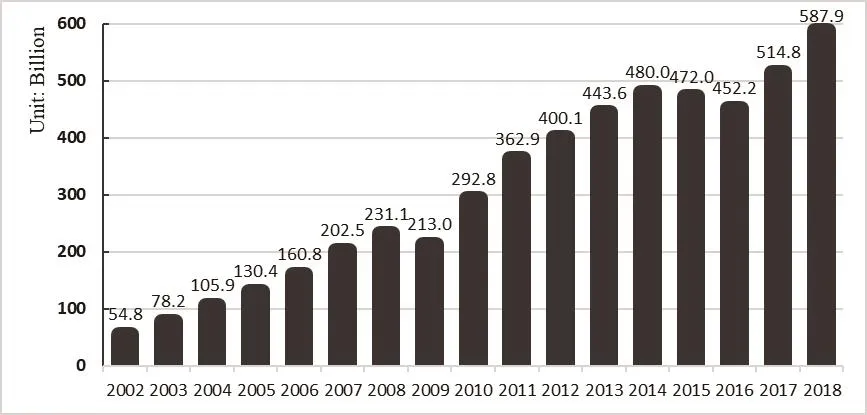
Table 1: China-ASEAN total trade volume from 2002-2018Data Source: Ministry of Commerce of the People’s Republic of China.
Besides, Guangxi Beibu Gulf Ports have played a significant role in this land and sea transportation network, with freight train lines to Chongqing and the four provinces of Guizhou,Sichuan, Yunnan, and Gansu, along with cargo ship lines from the Beibu Gulf Ports to Singapore and Hong Kong SAR.Lu Xinshe (formerly the Party Secretary of the Guangxi Zhuang autonomous region) holds that Guangxi is accelerating its infrastructure construction and facilitating multimodal transportation to keep the traffic flowing effectively along the trade corridor connecting China and the ASEAN countries.
Recently, Guangxi started moving towards integration into the Guangdong-Hong Kong-Macao Greater Bay Area, which is expected to facilitate the development of Guangxi in many social aspects and to create mutual benefits for both sides.The plan of the Guangdong-Hong Kong-Macao Greater Bay Area aims to develop the city cluster into a thriving global center of technology and innovation and a regional economic hub (China Daily, 2019).The focus is on transport infrastructure,industrial collaboration, and the flow of human resources as the inflow of technological talents with international vision and competitive capabilities is highly needed to further deepen reform andopening-up, which will feed the region’s economy with investments and advanced technology in the midst of globalization.
In the waves of opportunities and challenges brought by the BRI, new transport infrastructure provides the hardware, while people-to-people ties in the trade and intercultural communication are the crucial software.It is estimated that the total world GDP will rise more than 0.7 percent by 2030 because of increased trade facilitated by the BRI infrastructure.Half of this GDP gain will likely flow to BRI economies apart from China.In percentage terms, some Southeast Asian countries will also see sizable gains; Thailand (8.2 percent), Malaysia (7.7 percent), Cambodia(5 percent), and Laos (3.1 percent) (China Daily, 2019).The new trade made possible by the BRI infrastructure is creating a new generation of entrepreneurs and millions of job opportunities.A leading role in the digital economy era, China has become more influential via the integration of Chinese and international talents and by introducing world-class startups.The pie chart will show the percentage of four ASEAN countries.
To meet the current needs of the BRI, all social sections have made a contribution to the Initiative.On the government level, large amounts of money have been committed to tertiary education for cultivating international talents.On the institution level, a multilingual education policy was proposed by the Ministry of Education of the People’s Republic of China in its 13th five-year development plan for the national language industry in 2010.Thus, the cultivation of international talents with the mode of “Specialty + Multilingualism,” which aims to foster the advanced professionals with special expertise in the necessary fields and with multilingual capacity, has been the priority for foreign language education in the universities.Since then, much attention has been paid to multilingualism for “breaking language barriers between the BRI countries” (Ministry of Education of the People’s Republic of China, 2016).Besides, special funds have been granted to aid multilingual exchanges for 10,000 students from BRI countries, alongside the establishment of cultural exchange centers and activities (Office of the Leading Group for the Belt and Road Initiative, 2017).
Development of Language Acquisition Planning
Language policy is not only overt but also covert.“Overt” is via laws and regulations given by organizations, and “covert” could be inferred from observed practices (Bamgbose, 2006).R.L.Cooper’s (1989) concept of language acquisition planning overlaps with foreign language educationpolicies, which indicates that language planning activities are directed at the formal educational sector (Kaplan & Baldauf, 1997), and develops various regulations regarding foreign language teaching.The development of language acquisition planning should not only meet the needs of national politics and economics but should also follow the principle of locality that special and regional concerns should be addressed in the layout of language education.From the perspectives of the BRI, especially the opening up policy toward the ASEAN countries, the present language acquisition planning should be adjusted around the Initiative in a way that is specifically tailored to the relationships of the people-to-people ties that are attained through cultural exchanges.
The State Language Commission, the Ministry of Education, and all the governmental agencies concerned have served in the development and implementation of language acquisition planning and monitoring since the founding of the People’s Republic of China.In the 50s and 60s of the last century, Russian was taught as the main foreign language.In the late 70s, especially after the reform and opening up, English has been the first foreign language instead of Russian.For almost four decades since then, English has been the sole foreign language being taught and was included in the curriculum from third grade of primary school to the second year of tertiary education, a total of twelve years.Language acquisition policies and planning issued by the national education administration are often in the format of documents titled with planning, syllabus, curriculum standards, or teaching requirements.The following Table 2 lists some of the relevant documents issued by the Ministry of Education (MoE).
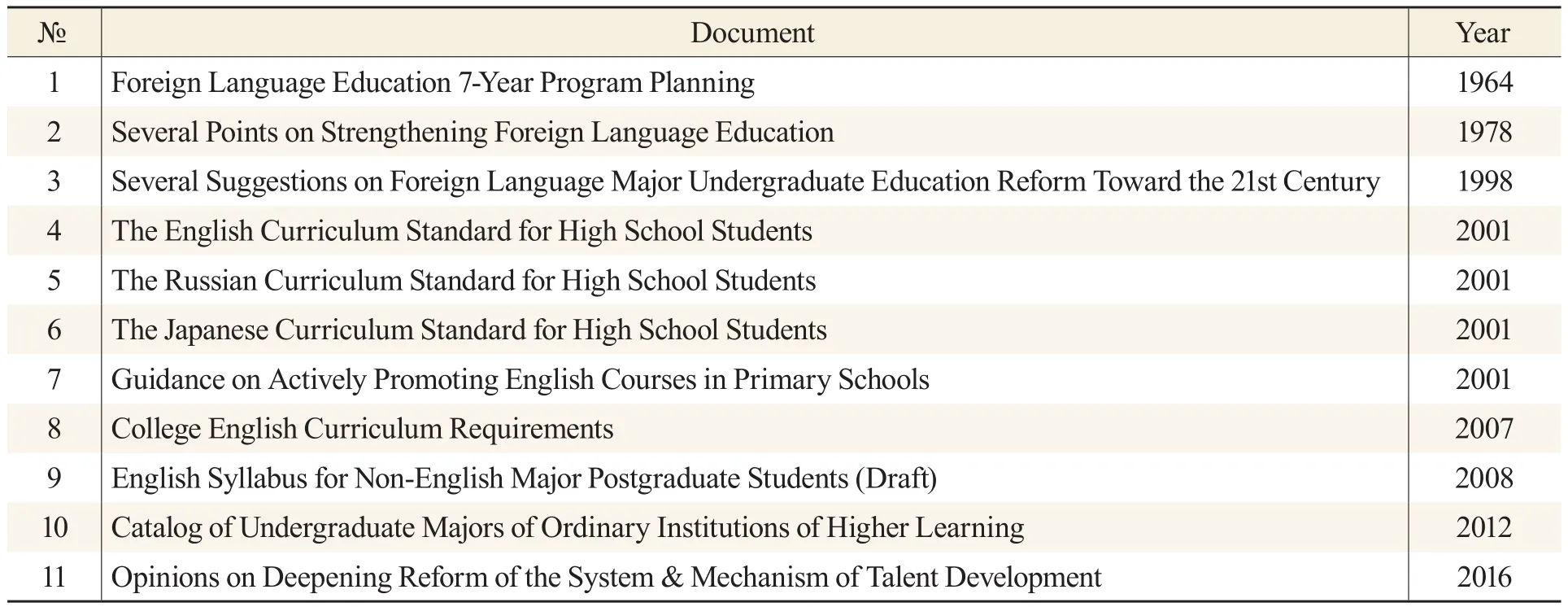
Table 2: Relevant documents issued by the Ministry of Education
According to the newly revised catalog of undergraduate majors in general institutions of higher learning, issued and implemented by the Ministry of Education in 2012, there are 62 majors in foreign languages and literature, including English, German, Russian and French.The Ministry of Education will actively guide qualified colleges and universities to adapt themselves to the needs of national and regional economics and social development and set up foreign language and literature related majorsindependently in accordance with the newly revised regulations on the management of undergraduate majors established in ordinary institutions of higher education.In response to the Chinese People’s Political Consultative Conference (CPPCC) proposals regarding planning for enhancing national language competence, the Ministry of Education of the People’s Republic of China unveiled a plan for the development of the national language industry during the 13th Five-Year Plan period (2016–2020)in 2016, with the aim of matching China’s language ability with its overall national strength by 2020.In the implementation of the BRI, the focus has been on innovations and developing international talents with multilingual competence and specialties.In this regard, particular consideration should be given to the training of foreign language talents in non-general languages to meet the current needs of global competition.To study and formulate multilingual foreign language planning, the Ministry of Education has made innovations in language services and training mechanisms for language talents to encourage institutions of higher education to improve the structure of foreign language teaching,and to train and reserve compound foreign language talents in key languages.Moreover, a reserve mechanism for the recruitment of language talents in emergency response and specialized fields has been established, to provide voluntary language services for major international events and disaster relief, and enhance our capabilities in language emergency response and assistance services.
In 2001, the Ministry of Education issued the policy that among English, Japanese, and Russian,the foreign language which is taught in the junior middle school could be one of the three choices mentioned above.In 2017, a policy on foreign language choice encouraged bilingualism in the senior middle school, which includes English, Japanese, Russian, German, French, and Spanish, to meet the different needs of foreign language acquisition.Based on the Common European Framework of Reference for Languages(CEFR), the Ministry of Education issued the first course standards for German, French,and Spanish for senior middle school.Moreover,multilingualism has been encouraged in the primary and secondary schools of some developed areas.To strengthen the talent cultivation of non-common languages, the Ministry of Education encourages universities and colleges to set up new majors to meet the needs of the BRI.Taking Beijing Foreign Studies University (BFSU)as an example, at present, BFSU offers over 100 foreign language programs and ranks among the top universities in the world for the quantity and variety of language programs with the official teaching of languages and regional studies fully covering the countries involved in the BRI (Beijing ForeignStudies University, 2019).
Multilingual Opportunities and Linguistic Challenges for Guangxi
Here I explore the huge opportunities as well as challenges that the BRI has brought to the development of Guangxi, with particular reference to fostering international talents with both English proficiency and multilingual competence at the tertiary education level, to ensure that Guangxi Zhuang autonomous region, which neighbors the ASEAN countries have competitive human resources with both technical specialties and language capacities to serve for the local economy and culture.
Multilingualism refers to the situation for the use of more than two languages (Swann et al., 2004, p.214).A well-known definition of multilingualism was given by the European Commission (2007), “The ability of societies, institutions, groups, and individuals to engage, on a regular basis, with more than one language in their day-to-day lives.” Multilingual competence refers to the ability of an individual or a speech community to use more than one language in daily communication with the speech community (ibid).Li (2008, p.4) defined a multilingual individual as “Anyone who can communicate in more than one language, be it active (through speaking and writing) or passive (through listening and reading).” Cenoz, J.(2013, p.4) holds that “Globalization, transnational mobility of the population,and the spread of new technologies” have contributed to the current visibility of multilingualism,which is highly influential in different political, social, and educational contexts.Globalization has increased the value of multilingualism.Speaking different languages has an added value.As Edwards(2004) pointed out, speaking English can be necessary, as it is the most widespread language in the world, and it is regarded as a language which helps to open doors for better economic and social opportunities, “but the ability to speak other languages none the less ensures a competitive edge”(p.164).Multilingualism includes multilingual ideology and multilingual order, on which language value and the choice of multilingual education depend (Zhou, 2006).The comprehensive forces of a country and the diffusion of a language are not based on linguistic considerations, but on political,cultural, and economic factors.Multilingualism in response to the BRI is a case in point regarding the multilingual opportunities that Guangxi is facing.
Abram de Swaan (2001) classified the global language system into four categories with an inverted tree diagram: at the bottom are peripheral languages, followed by central languages and super-central languages.At the top are hyper-central languages.In the linguistic map of the ASEAN countries, the top level is English, the international lingua franca, and the sole working language of ASEAN (ASEAN Charter 2007).Under de-colonization and globalization, some ASEAN countries have taken English as their national language, official language and as the medium of instruction in their education systems.Being the super-central languages, and the regional lingua franca as well,Chinese and Malay are in the second level of the linguistic map, with over one hundred million people using them, respectively.The popularization of Chinese in this region is because SoutheastAsia is the most densely occupied area for Chinese, various Chinese cultures like Confucian culture and Na culture integrate and melt together here.Bahasa Malaysia and Bahasa Indonesia, the two important variations of Malay, are mutually intelligible and differ largely only in the occurrence of more Dutch, Sanskrit, and Javanese loan words from Indonesia as opposed to more English loans from Malaysia, along with certain differences in pronunciation (Simpson, 2007).The third level is the central languages, which are the national language of each country in this region.Except for Thailand, all ASEAN countries had been colonized by European and American colonizers.Among the five countries of the Indo-China Peninsula, Vietnam, Laos, and Cambodia had been colonized by France.Thus their national languages, Vietnamese, Lao, Khmer, had also been greatly influenced by French, the former suzerain language.For example, their languages had been Latinized, and there were large numbers of loan words from French.With English globalization, Vietnam, Laos, and Cambodia united to appeal for French to be taken as one of the working languages of the ASEAN countries.Thai, Cambodian Khmer, and Lao are partly intelligible in language communication.In the Malay Archipelago, Filipino, Malay, Bahasa Indonesia, Bahasa Malaysia are the national languages of the Philippines, Singapore, Indonesia, and Malaysia.At the bottom of this linguistic map, peripheral languages are the national languages of some less-developed countries, due to their sluggish economies or because the national language is less used by the population because ethnic languages or vernaculars have gradually reduced the national language to peripheral status.Due to the worldwide spread of English as the international lingua franca in the wave of globalization, which has been pushed by the prevailing internet, many ethnic minority languages have been reduced to peripheral languages or endangered languages.
As for the language situation in Guangxi, there are over 12 ethnic groups with over 69 languages in the Zhuang Autonomous Region (Liu, 2005).Geographically adjacent to the ASEAN countries,with land bordering Vietnam and accessible sea lanes to Malaysia, Singapore, Indonesia, and the Philippines, Guangxi is China’s southern gateway to Southeast Asia and enjoys close ties with the ASEAN countries in cultural and customs conventions.Zhuang minorities are homologous with more than 20 ethnic groups in Vietnam, Laos, Thailand, Myanmar, and India, which have ethnically heterogeneous populations with common cultures, languages, and histories and maintain their original ethno-linguistic identities.Among them, five ethnic groups in Vietnam, i.e., Tay, Nung, Nguoi La Chi,Nguoi Pu Peo, San Chay, have a close sibling-like relationship with the Zhuang minority in Guangxi,and cousin-like relationships with the other 15 ethnic groups (Fan, 2005).Similarities in languages,toponymy, folk song melodies, civil religions, and physical anthropology may confirm that Zhuang,Thai (main nationality of Thailand), Lao Loum (main nationality of Laos), and Dai are homogeneous nationalities.Among the eight ethnic groups in the Tai-Kadai language family, the languages of the Zhuang, Bouyei, Dai, Dong, Shui, Maonan, and Li nationalities are similar to Thai.Also, the degree of similarity between the dialects of southern Zhuang and Thai is much higher (Fan, 2003).
The Zhuang minority has become culturally and ethno-linguistically assimilated to a considerable extent through extensive intermarriage and trading cooperation.Yet less attention has been paid to thelesser-known national languages of the neighboring countries in Southeast Asia.Geographically and linguistically, contiguous people living in the border regions with the same basic ethnic origins should be encouraged to learn their national languages in addition to English in the light of multilingualism and the increasing cooperation between Guangxi and the ASEAN countries in response to the BRI.
With decades of rapid economic development, China’s economic impacts on Southeast Asia have been growing through the implementation of the many and varied projects under the BRI, which China is making a significant effort to support.Cooperative opportunities between China and the ASEAN countries along the new Maritime Silk Road (MSR) have been increasing via promoting multilateral trade, offering both capital and technology in infrastructure construction, and strengthening intercultural communications.With the BRI moving ahead steadily since 2013, China and the ASEAN countries enjoy frequent high-level exchanges and ever-deepening people-to-people contact, thus enhancing mutual understanding through friendly connectivity.The tremendous business and employment opportunities generated by the Initiative have emerged, and people with technical skills who are familiar with the languages and cultures of the ASEAN countries are urgently needed.Multilingual international talents are highly welcome in the labor market.
When Bourdieu (1991) identified the sociopolitical implications of the use of different languages,he viewed linguistic practices as a form of symbolic capital, and multilingualism was seen as a socially constructed phenomenon where languages are sets of resources rather than fixed linguistic systems.Thus, English-plus multilingualism as the new linguistic capital is preferable in the current multilingual environment associated with the BRI in Guangxi.
English-Plus Multilingualism for Guangxi
Following the national foreign language education policy, Guangxi has constantly implemented the policy issued by the Ministry of Education, that is, English has been taught as the foreign language from grade 3 of primary school to the second year of tertiary education.Recently, bilingual education with both Standard Mandarin/Putonghua and English as the media of instructions has been popular in the colleges and universities of Guangxi.But, overall, the present language acquisition policy has not taken the geographical and regional factors into consideration when it comes to language planning in dealing with the local situation of Guangxi.This section will discuss the English-plus multilingual planning for Guangxi as it relates to the ASEAN-oriented region under the BRI.
Existing Problems of the Present Language Planning for Guangxi
Guangxi has constantly implemented the foreign language policy issued by the Ministry of Education, and political and ideological concerns have played a great part in shaping English as the main foreign language in Guangxi.Under economic globalization and regional integration, English language proficiency is regarded as an important asset to compete in the labor market.Owing to the four decades of reform and opening-up, Guangxi has witnessed remarkable achievementsin English language education.Often neglected, but not less important is the special locality of Guangxi, which leads to the aspects of structural layouts and language choices.The lack of adequate consideration of regional economic growth makes it hard for the current language acquisition planning to meet the needs of opening up to the ASEAN countries, which are famous for their linguistic diversity with more than 300 ethnic groups and over 1,000 languages, dialects, and vernaculars.According to the 22nd edition of Ethnologue (www.ethnologue.org), Southeast Asia is a special region for sociolinguistic fieldwork, as bilingual and multilingual phenomena prevail.Historical and geographical factors made Indian culture, Chinese culture, and the colonial suzerain cultures of Europe and America meet and integrate within this region.Under the BRI, Guangxi,the southernmost autonomous region bordering the ASEAN countries, has been faced with great multilingual opportunities and linguistic challenges.Therefore, it is high time to facilitate an English-plus multilingual planning for Guangxi in response to the BRI.
The existing problems in the foreign language education policy are obvious.First, top-down processing has been applied in the relevant policy planning.Thus the local regions have no autonomy in policymaking and implementation.Just as the locality has long been neglected, so have the realistic situations and different needs for the talents benefiting regional economic growth and social development.Second, lack of overall planning for a policymaking regional foreign language education equal to English language education.In general, language acquisition planning in Guangxi follows the “English Only” policy, so less attention has been paid to the national languages of the ASEAN countries, although they are geographically adjacent to the Southeast Asian countries.
Thus, the teaching of Vietnamese and Thai, the national languages of the Indo-China Peninsula,has been comparatively greater than the national languages of the other ASEAN countries.With geographical proximity, cultural affinity, and economic complementarity, Guangxi enjoys unique conditions and advantages for learning the national languages of the neighboring countries, but the current foreign language education policy ignores the teaching of the national languages of some small countries in this region.Due to the practical situation, language choice, and supplementary functioning of multilingual education, the special foreign language education policy for Guangxi should be planned in order to boost its social and economic development.Language learners in the cross-border region should be encouraged to learn one or more national languages of the neighboring countries to enrich their linguistic repertoires with multilingual ability, as language competence is regarded as one of the key capitals in human resources.
Also, Malay, the regional lingua franca of five Malay Archipelago countries, has been paid insufficient attention to.Indonesian, a variety of Malay, has only been taught in Guangxi University of Nationalities, in which an Indonesian major exists only at the undergraduate level.Yet the global trend of the widespread use of Malay cannot be ignored.Recently, the five Malay Archipelago countries that speak Malay have united to promote Malay for its unification of language and cultural communications and proposed that Malay should be one of the international lingua franca in the 21st century.A Malay major has been established in many colleges and universities around the world, andteaching and research on Malay are expanding rapidly due to the promotional activities implemented by the International Malay Council.
Considerations of Foreign Language Planning for Guangxi
From the national macro-level, ASEAN-China relationships are complex, although trade and investment links are generally strong.There is a growing need for China to invest more in foreign countries as domestic labor markets are becoming more competitive and costs are increasing.China has become an important source of much-needed capital for the building of infrastructure in the ASEAN countries.To support ASEAN as a Zone of Peace, Freedom, and Neutrality (ZOPFAN) and ASEAN Centrality as well, each country will surely take their own positions and strive to maximize their own interests when dealing with the complicated multilateral relationships with the superpowers concerned.Obviously, in the co-existence of both competition and cooperation in this region under the BRI, there is a growing significant role for China to elucidate Chinese orientation and initiative to the involved countries in the way of being perceived as a great country with responsibilities.As the second-largest economy in the world, China is faced with the task of telling well its stories, spreading its ideas, and winning the understanding of the international community, particularly in tackling the problem of how to tell China’s stories well to its global counterparts, to make China’s voice heard,and to improve the international impacts of China’s words.Thus, telling China’s stories well and constructing Chinese discourse systems through an in-depth study of international discourse systems are becoming increasingly important.Only by mastering the thinking mode of speaking a “global language” can we grasp international discourse power.Chinese is not yet an international lingua franca, and how to appropriately use foreign languages, especially the English language, to construct an international discourse system with Chinese characteristics is an urgent need.Especially for those countries that are skeptical about the BRI, China needs to convince the BRI-impacted nations and regions that the proposal is for win-win cooperation, and to do this, China needs to engage and listen to other countries and regional institutions to make this initiative more inclusive (Choi & Adamson,2019).To fulfill this great yet difficult task, a large number of talents with international visions and missions, high proficiency both in English and other foreign languages, familiarity with international rules, and professionalism in international negotiations are desperately needed.
The BRI, in terms of China’s domestic development, could enable China’s vast inland western regions such as Guangxi, Yunnan, and Northwest China’s Xinjiang Uygur autonomous region to improve internal economic integration and participate in global trade.Implementing these initiatives will improve inter-regional connectivity for the land-locked western regions and allow them direct access to port facilities in neighboring countries.For example, Guangxi needs cross-border economic links to achieve rejuvenation and economic prosperity.Its land connectivity with the ASEAN countries will be strengthened through cooperation on expressways, railways, and the development of infrastructure for its ports and airports.Guangxi borders Vietnam on land and is close to Thailand and Cambodia in Southeast Asia.This geographical advantage enables Guangxi to serve as aninternational gateway or as a connector between China and Southeast Asia, as well as a key littoral gateway for China’s BRI.
From the individual micro-level, one’s multilingual ability can enhance job opportunities and upward social mobility.Under the BRI, international talents with English plus multilingual proficiencies in the national languages of the ASEAN countries are highly needed in Guangxi.Indo-China peninsula countries such as Vietnam, Thailand, Laos, Myanmar, and Cambodia, which belong to English Expanding Circle countries (Kirkpatrick, 2010), have native languages of Vietnamese, Thai, Lao,Burmese, and Cambodian, respectively.In the Malay Archipelago countries, the official language of Indonesia, Malaysia, Singapore, and Brunei is Malay, which is also spoken in the south of the Philippines.Efforts have been made by the five Malay Archipelago countries to expand the use of Malay to become the regional lingua franca, but also to be one of the working languages in ASEAN.Exchanges and cooperation between Guangxi and the ASEAN countries have been more frequent than ever under the BRI, yet the capacity of dealing with multilingual and multicultural issues with the relevant countries needs improvement.Figure 3 shows the growth trend of students majoring in national languages of southeast Asian countries in Guangxi.
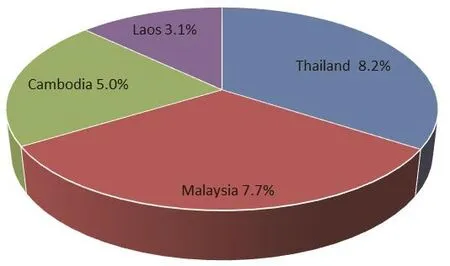
Figure 1: The estimated percentages four Southeast Asian countries will gain as a result of increased trade facilitated by the BRI infrastructure.Data Source: China Daily.
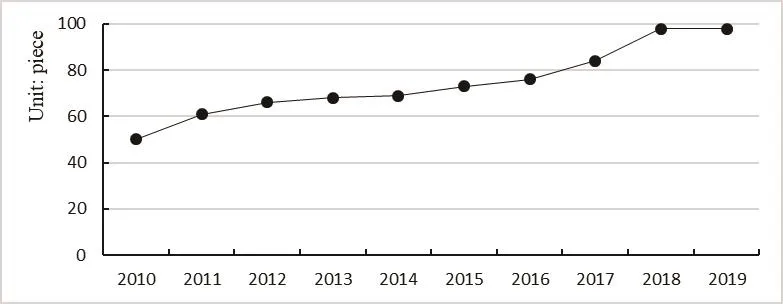
Figure 2: Language programs established in BFSU from 2010-2019Data source: Beijing Foreign Studies University
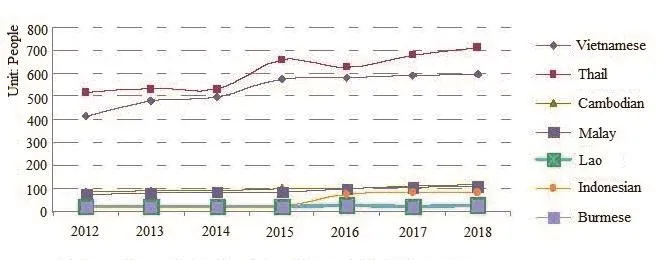
Figure 3: The number of college and university students in Guangxi majoring in the national languages of Southeast Asian countries from 2012-2018Data source: The official website of Gaokao
Guangxi is in urgent need of multilingual talents who are proficient in English (the sole working language of the ASEAN countries),Malay and Chinese (the regional lingua franca),and the national languages of the ASEAN countries to keep current in regional communications.During the process of integration, the relations between nations in ASEAN have become extremely complicated, as the infiltration and integration of mutual languages and cultures have been unavoidable.Thus, considerations must be taken when it comes to foreign language planning for Guangxi.The aspects of globalization and regionalization must be covered in policy-making.Multilingualism is a strategic resource needed to deal with globalization, and from the perspective of regional planning, Guangxi, the national minority autonomous region bordering the ASEAN countries, should adopt English plus multilingualism for the sake of cultural soft power and poverty alleviation via language acquisition planning.
From the institution level, currently, Southeast Asian languages which have been taught on tertiary education in Guangxi are in the following three levels: junior college, undergraduate andpostgraduate.Concerning foreign language teaching, there are a total of 78 universities and colleges in Guangxi.Among them, there are 38 undergraduate universities and 40 junior colleges.About 14 universities and colleges have set up Southeast Asian language majors, with more than 3000 graduates each year.Among them, there are 18 schools for Vietnamese major; ten schools for Thai major; three schools for Khmer; Lao, Burmese and Indonesian have been taught only in Guangxi University for Nationalities, the sole tertiary institutions of education conferring university-level qualifications,teaches Bhasa Indonesia in the undergraduate level, which is far from enough comparing with the pressing needs (The Department of Education of Guangxi Zhuang Autonomous Region, 2019).Look at the following Table 3.
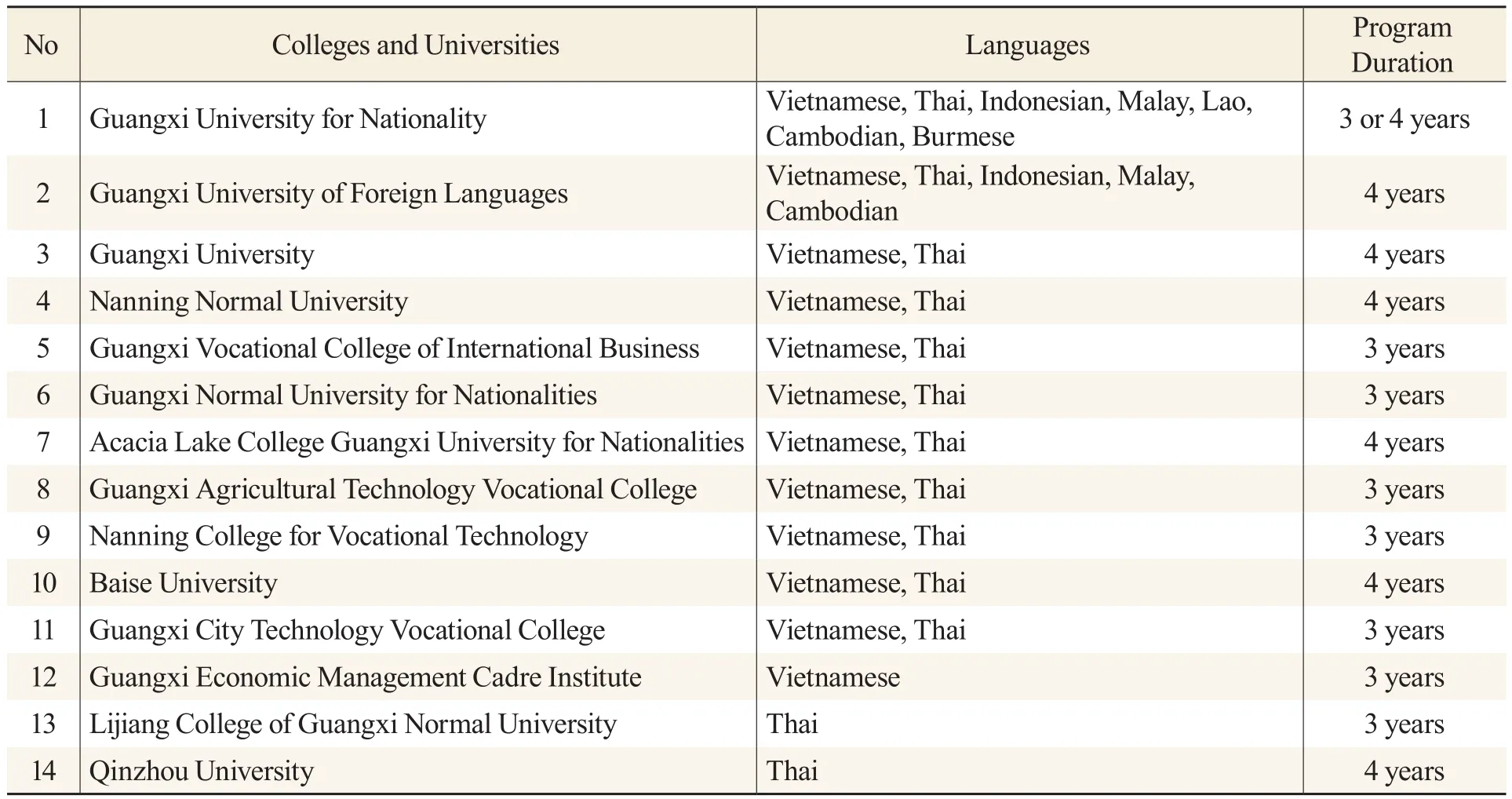
Table 3: Main national languages of the Southeast Asian countries being taught in the colleges and universities of Guangxi.
From Table 3, we see that the last three of the 14 colleges and universities mentioned offer only one national language of the Southeast Asian countries.Most of the colleges and universities, nine to be exact, offer both Vietnamese and Thai language acquisition programs.Guangxi University of Foreign Languages, a privately-run university, is the second batch of the national undergraduate universities as well.Furthermore, among the five Southeast Asian national languages, the Vietnamese and Thai majors ranked first and second respectively in the competitiveness ranking of China’s undergraduate education universities in 2015 (Guangxi University for Foreign Languages, 2019).Guangxi University for Nationalities offers the most language programs in Southeast Asia; there are seven majors for the national languages of the Southeast Asian countries.As the first undergraduate talents cultivating base of non-common languages in Guangxi issued by the National Ministry of Education, Guangxi University for Nationalities is also famous for its teaching and research regarding the languagesand cultures of the Southeast Asian countries.Separated from the School of Foreign Languages in 2013, the School of Southeast Asian Studies was set up in 2014 and offered seven majors for the national languages of the Southeast Asian countries: Vietnamese, Lao Thai, Cambodian, Burmese,Bahasa Indonesia, and Bahasa Malaysia.There are 637 undergraduate students and 44 postgraduate students, and a total of well over 1,000 full-time students in the School of Southeast Asian Studies in 2019 (Guangxi University for Nationalities, 2019).Among them, the non-common language major graduates of the national languages program of the Southeast Asian countries, such as Vietnamese,Thai, and Indonesian majors, are on the top of the employment list with an employment rate of 100 percent.Usually, graduates find work in higher education institutes for language teaching and research or in the field of diplomacy, tourism, economics, publication, radio and TV, foreign trade,business, etc.In the required courses, language research focuses on linguistics and translation, while cultural research focuses on literature and cultural anthropology.Besides, almost all the graduate students pass the College English Test, Band 4 (CET4), and over one-third of the graduate students pass the CET6 in English proficiency.While in the national languages program, majors of the Southeast Asian countries students are required to be certified as proficient in their languages before graduation.Therefore, graduate students are trained to be successful international talents with English plus multilingualism abilities.
As the south gate of China, Guangxi, one of the five autonomous regions on the provincial level,is a dwelling place of 12 ethnic groups.Ethnic minority communities are granted a certain degree of autonomy in government, education, and other aspects of socio-economic life by the Constitution of the People’s Republic of China.The government and legislative bodies in the autonomous areas have the power to pass laws and issue executive regulations that are adopted for special local circumstances so long as they do not violate state laws and regulations.The multilingual policy aims to encourage people to learn and use two foreign languages besides their mother tongue to help protect the cultural diversities through various means such as language acquisition programs, sponsoring translations of literal works, preserving regional dialects and ethnic minority languages.Therefore, for the sake of its unique geopolitical relations, cultural soft power and language services for the ASEAN countries should be taken into consideration when it comes to the planning of language acquisition policy in Guangxi.
Based on this analysis, language acquisition planning for Guangxi should be adjusted and replanned in response to multilingual opportunities and linguistic challenges related to the BRI.Measures should be taken to strengthen English proficiency to cultivate competitive talents in the labor market.Also, more of the non-common languages of the neighboring countries should be taught,such as Khmer, Lao, and Burmese, with the ultimate aim of covering all the national languages of the ASEAN countries.Furthermore, attention should be paid to the teaching and learning of Malay(including Bhasa Indonesia and Bhasa Malaysia), the regional lingua franca and a proposed working language of the ASEAN as well.By expanding language acquisition of English plus multilingualism,we can better cope with the dynamic situations that develop during the implementations of the BRI,promote social and economic development, enrich the linguistic repertoire of people in the Guangxi Zhuang autonomous region for poverty alleviation, better increase cultural soft power in cooperation with our Southeast Asian counterparts under the BRI, all via appropriate planning of foreign language acquisition policies in Guangxi.
Conclusion
China has recognized that in the globalized world, only truly multilateral solutions are appropriate as they allow cooperation and cultural interactions within the regions that have the potential to create enormous opportunities for all entities involved.After two decades of rapid growth, China is again looking beyond its borders for investment opportunities and trade.For China, it is an effort to initiate a big project with global implications.China needs to convince the BRI-impacted nations and regions that the proposal is for win-win cooperation.
UNESCO supports and encourages member states to promote inclusive education and sustainable development while promoting cultural and linguistic diversity via implementing multilingual policies in the education systems.As languages play an important role in understanding different cultures and achieving the UN goals of education for all, UNESCO has developed an action framework to promote inclusive language policies and sustainable development of multilingual education.China has always been at the forefront of promoting language diversity and promoting cross-cultural communications and mutual learning among civilizations through multiple languages.
Inspired by the multilingual language policy of the European Union, which encourages Europeans to learn and use two foreign languages in addition to their mother tongue, and based on the multilingual practice in Guangxi, this study analyzed the current situation of multilingual opportunities and linguistic challenges that Guangxi has encountered due to its unique geographical position.This paper proposes that English plus multilingualism programs be incorporated into the Guangxi language acquisition planning in response to the BRI from the perspectives of governments,educational institutions, and individuals, and suggests how multilingualism is promoted through language acquisition planning in relation to the BRI in Guangxi.
 Contemporary Social Sciences2022年2期
Contemporary Social Sciences2022年2期
- Contemporary Social Sciences的其它文章
- The Historical Fiction Based on True Stories: An Analysis of the Menghui Gushu by Huang Jianhua with the Aid of Historical Records and Archaeological Objects of Art
- Research on the Impact of Venture Risk Tolerance on R&D Investments:Based on Entrepreneur Ability
- Research on Big Data Platform Design in the Context of Digital Agriculture: Case Study of the Peony Industry in Heze City, China
- A Preliminary Study of Embedded Supervision Thoughts: Based on a Distributed Financial System
- Financial Knowledge, Capability to Guard Against Risks, and Rural Households’ Selection of Financial Assets: An Empirical Study Based on Rural Households in China
- A Brief Introduction to the English Periodical of Contemporary Social Sciences
